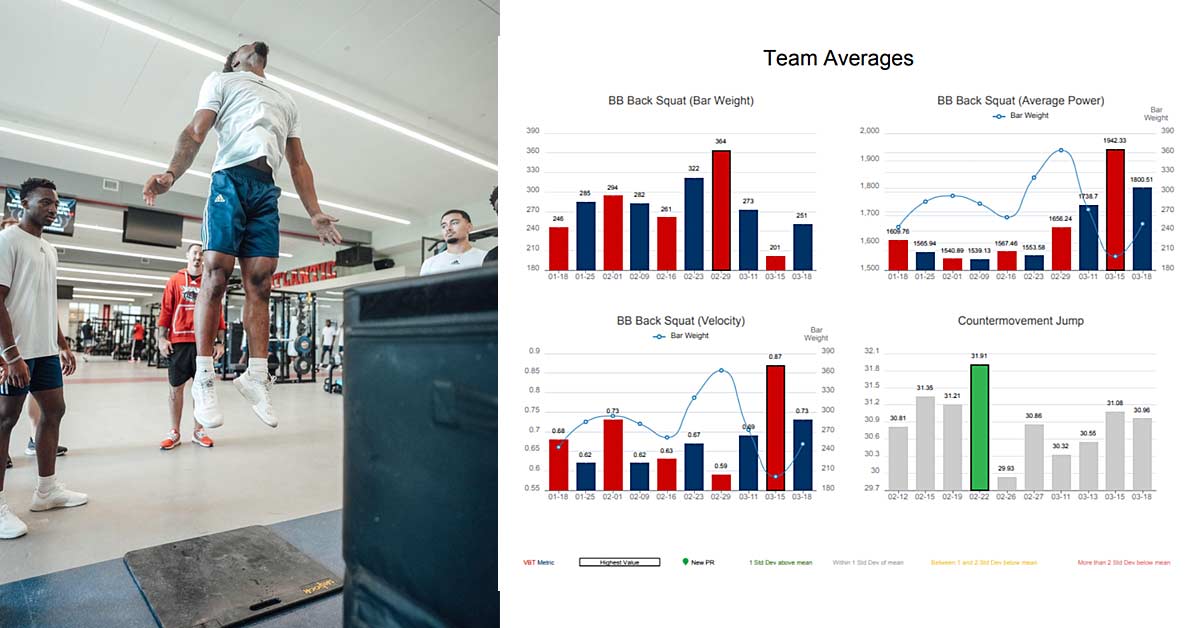New developments in technology have resulted in more testing tools that enable strength and conditioning coaches to gather large amounts of data. Along with the emerging field of sports science, the data management market has developed a specific need: digesting and interpreting these newfound metrics to convert them into actionable information. This has produced the need for AMS systems.
The hardware involved in testing technology improved by leaps over the past decade, but the software portion lagged. However, with the current emergence of software upgrades, it is getting easier to process data in real time.
Automated testing stands out as a potent tool for enhancing player performance, tactical understanding, and overall team efficiency, as it consolidates data into easy and understandable reports much more quickly than the countless hours it would take a coach to create by hand. What would have taken days now takes minutes through AMS systems and API keys.
Automated testing stands out as a potent tool for enhancing player performance, tactical understanding, and overall team efficiency, says @CoachJoeyG. Share on XThis article delves into the benefits of automated testing within the context of football teams, highlighting its transformative potential in elevating training regimens, injury prevention strategies, data gathering, and our return-to-play program.
Standard player testing and monitoring generally consists of a handwritten outline of jumps, sprint times, weight lifted, mobility deficiencies, etc., for 100+ athletes. This is then followed by manually inputting these data points into a spreadsheet. Once all these data points have been inputted, the interpretation process begins.
Our goal was to expedite this process with companies that automatically collect performance data, such as Skyhook, Enode Pro, Speed Signature, Fusionetics, and Catapult. We then use DataViz, which centralizes these data points on its platform and gives us the ability to take care of the interpretation process automatically.
Enhanced Training Regimens
Automated testing with football teams offers a systematic approach to assessing players’ physical capabilities, technical skills, and cognitive abilities. Through the utilization of specialized sensors, motion-tracking devices, and data analytics platforms, coaches can obtain comprehensive insights into players’ performance metrics during training sessions. These insights enable coaches to tailor training regimens to address individual strengths and weaknesses effectively.
For instance, wearable Catapult GPS devices equipped with accelerometers and gyroscopes can precisely measure players’ movement patterns, including sprint speed, acceleration, deceleration, and changes in direction. By analyzing this data, coaches can identify areas for improvement in agility, speed, and explosiveness, thus optimizing training drills to enhance specific physical attributes required for football. Not only can coaches see what physical attributes need improvement, but they can also craft interventions for upcoming workouts or practices with the information provided by the automated reports.
GPS DataViz is a data management company that we utilize to provide detailed reports summarizing a workout or practice. We get bullet points that explain where players are compared to previous sessions, and they get flagged if they are off their averages. These alerts are provided to coaches five minutes after downloading, making the information transfer quick and allowing more time to make adjustments for the following sessions.
In previous years, the digestion of data and interpretation of GPS data was not only time-consuming but also labor-intensive for a strength and conditioning coach. With systems like DataViz, we can now press one button and receive a much more detailed account of a workout or practice in five minutes, freeing up the coach to actually coach instead of guard their desk.
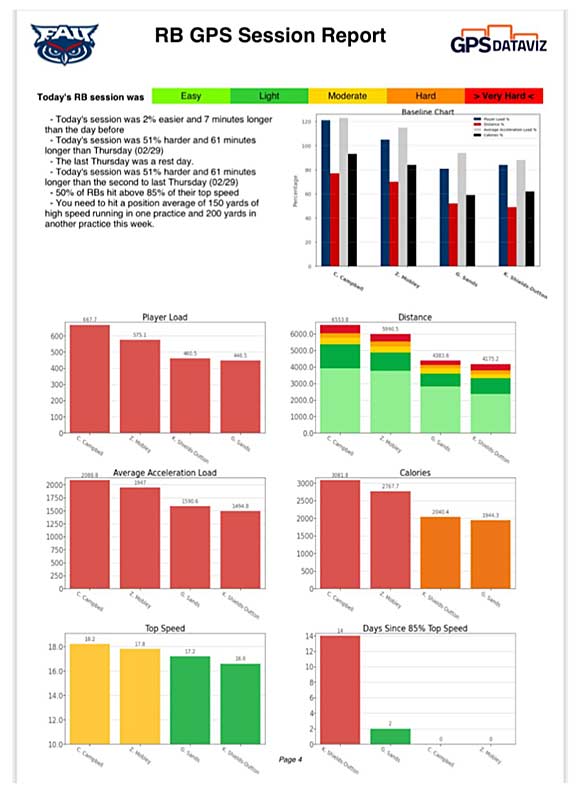
Speed Signature is another system that has enabled us to fully automate our testing. Its technology further breaks down our Catapult GPS and accelerometer data and gives us an in-depth look at power output, sprint times, deceleration times, and even asymmetries while running.
Through Speed Signature, we can get a number of acceleration metrics from our static start and linear sprints. The main metrics that we look at are 10-, 20-, and 40-yard sprint times, force, peak power, time to peak power, and peak GPS speed. We also utilize deceleration metrics, such as change in speed, decel time, early decel time and percentage, late decel time and percentage, and peak speed into decel.
These are just the handful of metrics that we look at from their platform; there are others to choose from. Speed Sig’s technology has the capability to get a multitude of metrics from upright running sessions as well. Through the use of a special Catapult waist harness that Speed Signature provides, we can look at metrics such as ground contact time (GCT), horizontal power, vertical power, hip lock, stride frequency, and stride length, to name just a few. These metrics can then be compared at different speeds, against norms, and between limbs.
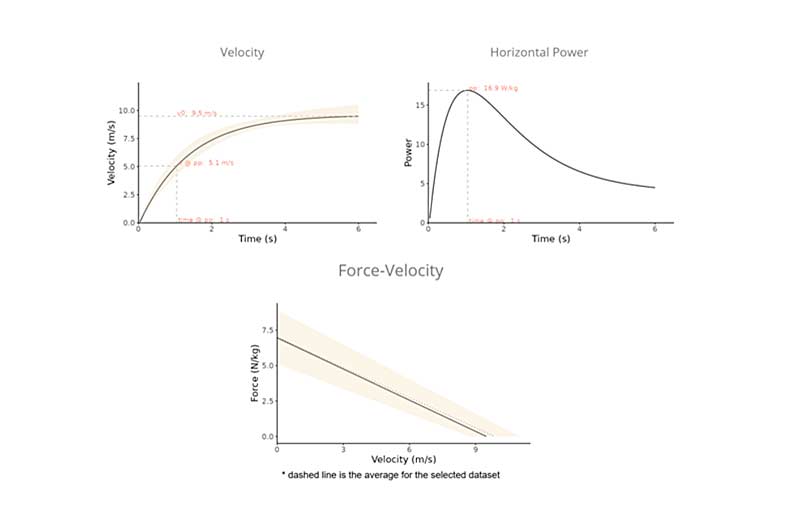
The data gathered by these different devices also provides coaches with instantaneous feedback. This feedback helps drive intent from athletes, which will, in turn, create better scores (yelling “mph” in practice, for example).
All athletes have a common drive, and none wants to lose a competition. For instance, if we test countermovement jumps on our Skyhook jump mat, we get instant scores that pop up on the screen. Other athletes see their teammates’ scores and immediately want to beat them. With this live feedback, we can relay scores and times back to athletes to help create that competitive environment. It is a way to make training fun and get the most out of each drill.
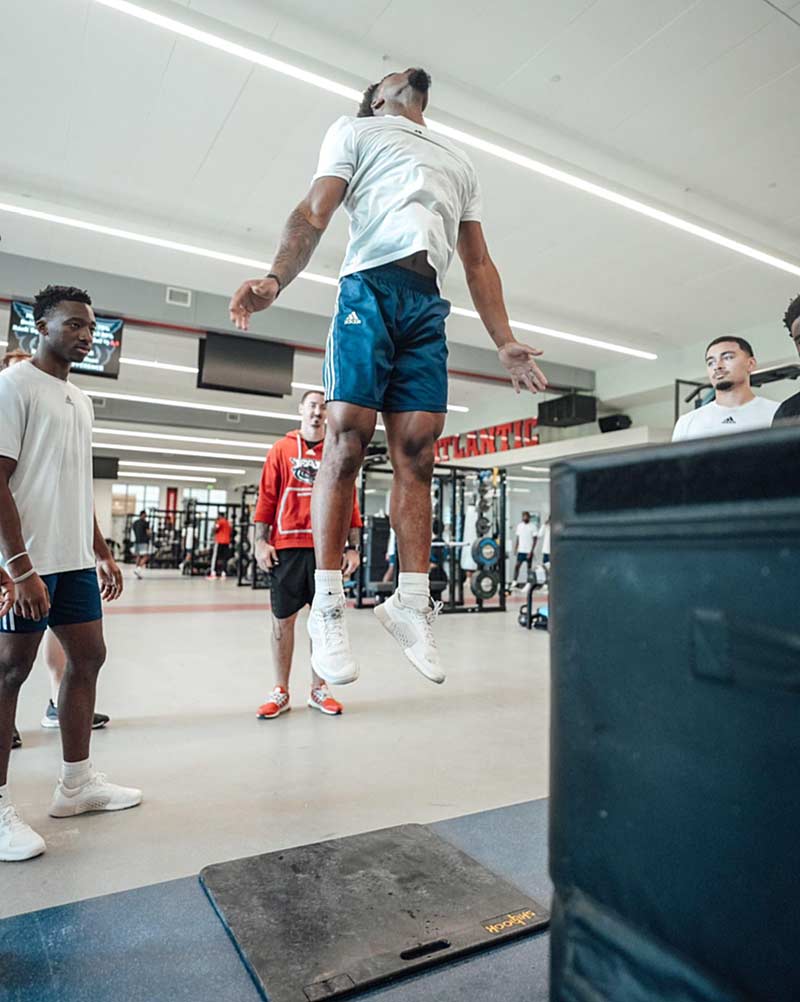
Velocity-based training (VBT) has been a large part of how we gauge our training stimuli in the weight room. How fast your athletes move the bar can give you a lot of insight into how they feel on a particular training day, as well as give you an idea of how your entire team is trending over time.
Enode Pro has enabled us to view all of our athletes’ power outputs, weights lifted, and velocity for every set and rep we have them perform. This is an overwhelmingly large amount of data, as you can imagine, and it would take considerable time to decipher and find trends. As with the previous platforms we have discussed, coupling Enode Pro with DataViz simplifies this process.
Writing out an eight-week training program and hoping it works is a thing of the past with automated data systems like GPS DataViz and technology such as VBT, says @CoachJoeyG. Share on XWithin minutes of a session’s conclusion, we are able to generate a report that shows us averages for our Enode Pro metrics and compares them against previous sessions. The ability to view this data takes the guesswork out of programming. Sets, reps, and percentages look pretty on a sheet, but is your training goal being executed correctly?
Was your Week 8 power output the highest of the training cycle, as you had planned? Was the bar velocity goal met that day? If not, maybe the percentages were too low, and adjustments can be made. These reports give you another set of checks and balances to help guide your training.

Injury Prevention Strategies
Injuries pose a significant challenge for football teams, often sidelining key players and disrupting team dynamics. Automated testing plays a pivotal role in injury prevention by monitoring players’ biomechanics, workload distribution, and physiological parameters. By leveraging wearable sensors and advanced biomechanical models, we can identify potential injury risks and implement targeted interventions to mitigate them.
Fusionetics plays a pivotal role in how we assess and attack mobility in our athletes. This is a company that helps us test, organize, and program what type of mobility exercises we use for our athletes. In the new age of college football, roster turnover is larger than ever, and there has to be an easy and efficient way to test athletes as soon as they step foot in the facility.
Fusionetics allows us to do that with its 3-D picture technology. Assessments take five minutes and give us an instantaneous report with asymmetries, deficiencies, and a score that we can compare to the rest of the team. This allows us to quickly address an athlete’s needs and keep an eye on areas that need further development to reduce the risk of injury.
Programming and tracking your team’s progress is easy as well, and everything is organized for you. Being able to see where certain athletes lack a range of motion and grouping them together so their program can attack and focus on that deficiency is important for us. This gives us room to grow with our mobility program, and guys always know what goals they want to hit.
Programs are tailored to that athlete’s needs, and we can see how many times they have completed their scheduled programs. Whether they are categorized as a “high needs hip player” or “high needs ankle player,” we can schedule them to perform at least one of those needs a week. This allows us, as coaches, to focus more on that athlete and their progress rather than playing the guessing game on what they actually need. Fusionetics takes the guesswork out of mobility, and we see instant progress in our athletes’ movement efficiencies.
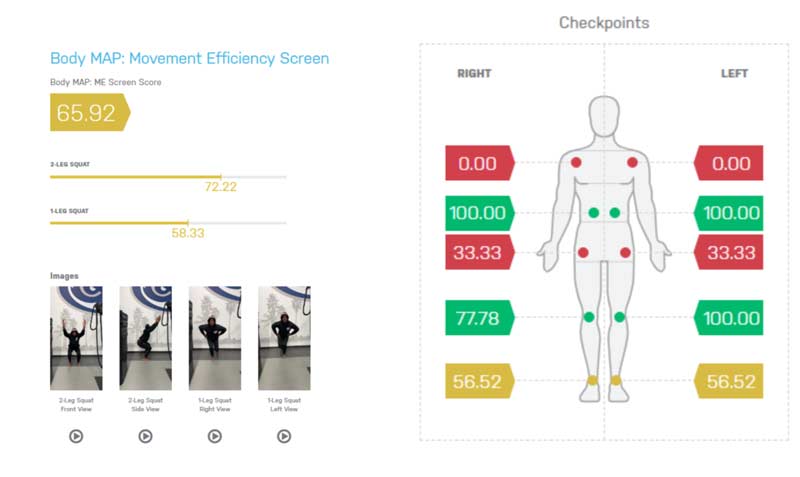
GPS monitoring of players’ running gait and biomechanical alignment can also detect asymmetries or compensatory movements that expose them to injuries such as muscle strains or ligament tears. By analyzing these data patterns, we can prescribe corrective exercises, adjust training loads, or modify playing techniques to prevent injury occurrence. Getting this information from so many different testing devices in such an efficient, consolidated, and accessible manner gives us the information we need as a staff to make sure we train smart and get the most out of our athletes every day.

Moreover, automated testing facilitates the monitoring of players’ physiological responses to training loads and game demands. By tracking parameters such as heart rate variability, lactate threshold, and recovery kinetics, we can optimize training periodization and ensure adequate recovery periods between intense sessions. This proactive approach to injury prevention not only reduces the likelihood of player injuries but also enhances team performance by maintaining optimal player availability throughout the season.
Laser timing systems and GPS play a crucial role for us on our max velocity days. The lasers do two important things for us:
- Give instantaneous feedback that helps drive intent and competition between our athletes.
- Provide an effective compass for how our athletes feel that day.
If we see times slowly start to drop off, or if numbers are not as good as we expect, this gives a good indication to start cutting athletes off and not running them anymore. The players might be in a very fatigued state, especially late in the training block, which can then lead to soft tissue injuries. Feedback from the lasers and GPS tracking systems will allow us to autoregulate our athletes and make smart decisions about how we are training them.
The Skyhook jump mat also gives us a very important KPI with our countermovement jumps. Each athlete has their own profile, which makes it simple and easy to keep track of their PRs and trends to how they are jumping. If we start to see a 5% decrease from their personal best to where they are jumping currently, it lets us know they are fatigued, and performance can begin to decline. On the flip side, if we are getting a lot of PRs—which will pop up automatically right after an athlete jumps—we know our guys are fresh and ready to go for the practice/competition that is coming up.
This feedback and profiling make it easy to keep track of our team’s trends and whether we are heading in the right direction with our training. On the other hand, we can see outliers with our athletes, and if we have an athlete whose jumps might be down, we know to monitor him and watch his progress in training and practice.
Keeping Track of Data
One remarkable benefit of automated testing in football teams is its ability to streamline the process of data collection, management, and analysis. Traditional methods for tracking player performance and match statistics often rely on manual data entry, which can be time-consuming and prone to errors. Automated testing solutions, however, offer a more efficient and accurate approach to data management.
Automated testing solutions, however, offer a more efficient and accurate approach to data management, says @CoachJoeyG. Share on X
By leveraging integrated data collection platforms and cloud-based storage systems, we can easily capture and organize a wealth of performance metrics, injury records, and tactical insights. Whether tracking players’ training loads, monitoring injury rehabilitation progress, or analyzing match statistics, automated testing simplifies the data management process, allowing us to focus on what is important to our athletes and enabling us to coach them all the time and not just sit at a computer all day.
Skyhook enables real-time data synchronization across its platform and an easy transfer to its cloud, so everything is stored and saved if we need it later. We also have an API key set up, which is sent to our data management company; they filter all the data, show how we are trending, and produce a breakdown for each individual athlete. This process allows us to send out detailed reports within minutes of completing that training session, and athletes can see their progress day by day. Coaches can also access up-to-date performance metrics during training sessions, while medical staff can remotely monitor players’ injury statuses. This seamless flow of information enhances team coordination and transparency, fostering a data-driven culture that results in performance excellence.
Skyhook enables real-time data synchronization across its platform and an easy transfer to its cloud, so everything is stored and saved if we need it later, says @CoachJoeyG. Share on XAutomated data has drastically improved the time and effort it takes to upload everything and send it to sport coaches. One of the cardinal sins of data collection is to just throw a bunch of meaningless numbers at sport coaches and charts that they do not understand. Automated data cuts our work time in half; all the data is cleaned, and all spikes have been taken out by the time we look at it. “Spikes” are any outliers or numbers that do not fit the data or something that is just generally not possible. An example would be seeing a 50-inch countermovement jump on one of our player’s profiles.
Data cleaning helps us save time and put effort into ensuring what we send to coaches makes sense and only gives them what is needed and essential. Our goal is to make data as simple and digestible for all coaches, and automated data by Skyhook and all our GPS tracking systems allow us to do that.

Return to Play
One of the biggest issues we have had in the past is being limited to the data we collect and what we can get out of it. Like our athletes, coaches are competitive, and we always try to find an edge to put our training above other people around the country. The Skyhook jump mat allows us to take our data collection to a new level because we are not limited to countermovement jumps. We have the choice of a wide range of features, including RSI, depth jump height, ground contact times, and flight times. This allows us to explore different KPIs and get more specific with our training.

RSI is an important KPI for us, especially with our return-to-play group. The metric allows us to track their reactivity to the ground and their muscle-tendon stress, which is very important for guys who have had an ankle injury and are rehabbing. We can tell by their RSI score if they are being reactive and “springy” off the ground or if they are more strength-dominant (which we see when their GCTs are longer). The higher their RSI score, the springier and more elastic their tendons are—which is a good indicator that we are building strength back up. This is one of the many options that Skyhook gives us that helps separate our training from other programs.

Moving Forward with a New Paradigm
Automated testing integration represents a paradigm shift in training methodologies, injury prevention strategies, data collection and sorting, and return to play for athletes. By harnessing the power of technology to collect, analyze, and interpret vast amounts of data, we can gain a competitive edge in an increasingly demanding and dynamic sport landscape.
From enhancing training regimens and reducing injury risks to refining training strategies and optimizing our return-to-play program, automated testing serves as a masterful tool for unlocking the full potential of players and teams alike.
Skyhook and our various data collection tools enable us to gain this edge with our data collection, and we can tailor our training to each athlete and position group. The ability to get instantaneous feedback allows us to deliver information to coaches and athletes quickly. It eliminates time for us as a strength staff just sitting on a computer, trying to implement and clean data. As football continues to evolve, embracing automation will be instrumental in shaping the future of the sport and driving performance excellence at all levels of competition.
Since you’re here…
…we have a small favor to ask. More people are reading SimpliFaster than ever, and each week we bring you compelling content from coaches, sport scientists, and physiotherapists who are devoted to building better athletes. Please take a moment to share the articles on social media, engage the authors with questions and comments below, and link to articles when appropriate if you have a blog or participate on forums of related topics. — SF
 Zackary Ceci started his career as an intern at FAU in 2022. He also spent time at the University of Tennessee as an intern and even in the private sector at “Triple F” in Knoxville, Tennessee. Ceci was hired back on staff to FAU in the summer of 2023, and over time at these various stops, he gained knowledge in advanced technologies such as: Elite Form, Catapult, Kinovea, Vitruve, and Dartfish. Ceci has worked with a wide range of athletes, from K–5 all the way up to NFL athletes, and he currently oversees the mobility program and assists in implementing the intern curriculum at FAU.
Zackary Ceci started his career as an intern at FAU in 2022. He also spent time at the University of Tennessee as an intern and even in the private sector at “Triple F” in Knoxville, Tennessee. Ceci was hired back on staff to FAU in the summer of 2023, and over time at these various stops, he gained knowledge in advanced technologies such as: Elite Form, Catapult, Kinovea, Vitruve, and Dartfish. Ceci has worked with a wide range of athletes, from K–5 all the way up to NFL athletes, and he currently oversees the mobility program and assists in implementing the intern curriculum at FAU.
 Robert Marco played four years of football at Washburn University, followed by a brief stint playing professionally from 2018–2019. Marco began his coaching career as a volunteer strength and conditioning assistant at the University of Kansas in 2020 and had his first paid opportunity at FAU with Coach Joey Guarascio in 2021. He then took another assistant job opportunity at Liberty University and Coach Dominic Studzinski in 2022. Following the 2022 season, Marco was brought back to FAU as Associate Head Strength Coach by Coach Guarascio.
Robert Marco played four years of football at Washburn University, followed by a brief stint playing professionally from 2018–2019. Marco began his coaching career as a volunteer strength and conditioning assistant at the University of Kansas in 2020 and had his first paid opportunity at FAU with Coach Joey Guarascio in 2021. He then took another assistant job opportunity at Liberty University and Coach Dominic Studzinski in 2022. Following the 2022 season, Marco was brought back to FAU as Associate Head Strength Coach by Coach Guarascio.

